First World War Project
Charles Alfred TOLHURST (Lynsted with Kingsdown)
b. 1883; Private, Service Number L/7881 |
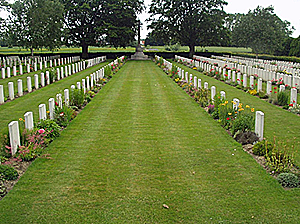
Charles was the first Lynsted casualty of WW1, being killed in action in the early months of the war. Charles was born in Kingsdown in 1883, the third of 13 children of George and Jane Lucy Tolhurst (née Milner). His two older brothers were George and Frederick, and his younger siblings were Albert, Ada Jane, Lucy Annie, Elizabeth Ellen, Emily, Marion, Florence, Isaac and Valentine. Sadly Charles's mother died, probably whilst giving birth to her last child, Franklyn, in 1904 at the age of 44. The family lived at several addresses in Erriot Wood and Kingsdown. By the time of the 1911 Census, however, Charles's father was living in Yew Tree Cottages, Kingsdown, with two of his daughters, Lucy and Marion. The youngest child was living with his grandparents.
Records show that in May 1902 Charles joined the territorial army at Canterbury at the age of 18 years and 2 months and was assigned to 3rd Battalion, The Buffs (East Kent Regiment). During 1902 he undertook 49 days of drill training. On 1 March 1904 he signed up as a full-time soldier and probably served for four to six years. This experience would prove crucial and led to his recall at the outbreak of war and his posting to France with the British Expeditionary Force.
Charles married Juliana (also known as Jaleane and Ialeane) May Randall Neaves on 5 January 1910 at St Margaret's Church, Wychling. In the 1911 Census he was working as a farm labourer and living in Anchor House (in recent years renamed The Old House), Lynsted, which at the time was split into three dwellings. With them were their first daughter Margaret May, born on 16 July 1910, and Jaleane's 9 year old sister, Elizabeth Ellen. Two more daughters followed, Lilian Rose on 7 August 1912, and Eva on 31 August 1913.
At 10.00pm on 4 August 1914, the order for mobilisation was issued. Charles was recalled and assigned to 1st Battalion, The Buffs (East Kent Regiment), which was to become part of the 16th Brigade, 6th Division of the British Expeditionary Force. Charles's short service was to be hard.
By 18 August the 6th Division came together in camps around Cambridge and Newmarket. The next 20 days were spent in intense training. During this time the locals took the soldiers to their hearts, putting together canteens and recreation rooms for their use. As with a lot of other troops, the men grew impatient to get to France as they feared that they would miss out on battle. This stemmed from the common belief that "it would all be over by Christmas".
On 8 September 1914, their journey to France began as the troops were taken by train to Southampton. They landed at St Nazaire on 9 September. There followed a long train journey to billets in Coulommiers, Mortcerf, Marles and Chaume, where they arrived on 12 September. The period 13 to 19 September was spent on a long march to the Aisne area to the Divisional Headquarters at Bazoches. Here they relieved troops who where exhausted from the big retreat from Mons, hard fighting on the Marne and the first few days of the Battle of the Aisne.
Between 19 September and 11 October, Charles took part in heavy fighting in the trenches along the Aisne, during which time 1,482 were killed. This battle saw the start of trench warfare. On 12 October the Division marched on to Hazebrouk, where the following day they went forward to Cassel by train.
The First Battle of Ypres started on 13 October and the following day Charles's Division reached the front line at Rue du Leet-Blanche Maison, just east of Bailleul. Over the next few days fighting was intense. The battalion war diary reports:
| 15-16 Oct | Crossed the River Lys at Sailly. During the night Steenwerck was occupied. |
| 16 Oct | Line advanced to Rouge du Bout - Rue Dormoire. |
| 17 Oct | Grenier-Chapelle d'Armentières reached without opposition. |
| 18 Oct | After considerable fighting, line moved forward to west of Pèrenchies-l'Epinette. |
| 19 Oct | Trench digging. |
| 20 Oct | A massive German attack along the whole front line. |
| 21 Oct | Line driven back. |
| 22 Oct | Under intense attack, but held firm. |
| 23 Oct | Repulsed an attack causing many enemy deaths (at least 300 reported dead in front of the line). |
| 24-25 Oct | Continuous attack all day. Although line held, the situation was becoming critical. |
| 25-26 Oct | During the night the line moved back about half a mile to prepared trenches in order to straighten line. |
| 27-28 Oct | Line taken by the enemy during the night, but taken back in a counter-attack. |
| 28-29 Oct | Night attack repulsed. |
| 29-30 Oct | Strong attack during the night when trenches were captured, but re-taken in a counter attack. |
So ended the First Battle of Ypres with the loss of 4,696 men. The period from 24th October is also the subject of soldiers' stories found in the Daily Express of 23rd November 1914.
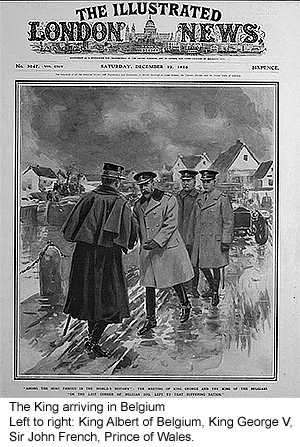 During November active fighting died down and the Division was entrenched on the Armentières front from then until the end of February. During which time 3,950 soldiers were killed either by shelling or sniper fire. But during this time a new enemy emerged. November and December saw appalling weather. Trenches were water-logged and knee deep in mud. With a lack of warm clothing and inadequate food, troops were falling foul of frostbite and trench foot. The parapets of the trenches were so water-logged that they failed to act as a shield from sniper bullets and many men were lost.
During November active fighting died down and the Division was entrenched on the Armentières front from then until the end of February. During which time 3,950 soldiers were killed either by shelling or sniper fire. But during this time a new enemy emerged. November and December saw appalling weather. Trenches were water-logged and knee deep in mud. With a lack of warm clothing and inadequate food, troops were falling foul of frostbite and trench foot. The parapets of the trenches were so water-logged that they failed to act as a shield from sniper bullets and many men were lost.
One event that may have briefly lightened the mood was reported in some war diaries when, for the first time since 1743, a reigning monarch visited the front line on the 2 December 1914. King George V, along with the then Prince of Wales (later to become Edward VIII), visited the British Expeditionary Force during a five day visit to troops.
It was reported at the time that the King was a little bemused when he inspected the troops to find them dressed in woolly balaclavas and emptied sandbags sacks, stuffed with straw, strapped around their putties. Possibly the cold and wet conditions in which the troops were fighting had not fully been recognised.
| From The Times 14 December 1914 |
| KING GEORGE'S OBSERVATION POINT AMSTERDAM, Dec 12 The Sluis correspondent of the Telegroof writes:-
|
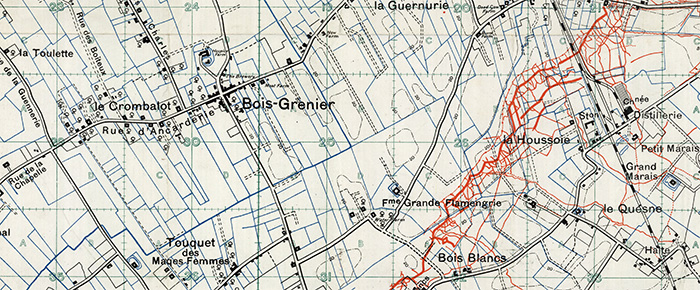
Only five days after this report was published in The Times, Charles was killed by a sniper's bullet - the only man of his battalion to die on 19 December 1914.
| Charles's death was announced in the East Kent Gazette on 2 January 1915 |
|
LYNSTED MAN KILLED AT THE FRONT. Much sympathy will be felt for Mrs Tolhurst and family, of Ludgate Farm, Lynsted, who have been informed by the officer of his company that their husband and father was killed in action, in Flanders, on December 19th. The deceased was Private Alfred [sic] Tolhurst, of the 1st Battalion, The Buffs, and he was 29 years of age. He worked for Mr. W. Farmer, and, being a Reservist, was called up at the outbreak of the war. Private Tolhurst went through the battle of the Aisne, and he took part in the severe trench fighting in which the Buffs participated in Flanders. After their first severe stretch in the trenches the Buffs were relieved, and had a fortnight's rest. They returned to the trenches for another spell and on the second day at the fighting line Private Tolhurst was killed by a German sniper. He leaves a widow and three young children. |
| Charles's death was also announced in the Faversham and North East Kent News on 9 January 1915, following up with a fuller report on 6 February 1915: |
|
LYNSTED We recorded recently the death of Alfred Charles [sic] Tolhurst, of the 1st Batt. The Buffs, who was killed in action at the Front. In a letter to Mrs Tolhurst, Capt Hardy, commanding B Company wrote:- "….. He and I were trying to locate some German guns which were shelling our trenches. My eyes had got tired, I handed over the telescope to him and went away for a few minutes. A bullet came through the loophole and passed through his head, killing him instantly. I cannot tell you how deeply I sympathise with you and yours in your dreadful loss, but it must be some comfort to you to think that he died gallantly serving his country, and no man could have a finer death …. He will be sadly missed in the Company, both as a soldier and a good friend and companion." The deceased has left a wife and three young children. |
Ironically, Charles's colleagues in the 1st Battalion, The Buffs, were to take part in the now famous Christmas Truce. Just one day after his death, soldiers from both sides were reported to be coming out of their trenches to bury their dead. Charles's body was buried by his colleagues, probably just behind the front line.
Charles was named again in the Faversham and North East Kent News in their Roll of Honour published on 7 August 1915 commemorating the anniversary of the outbreak of war.
In 1917, Charles was posthumously awarded the 1914 Star (colloquially known as the Mons Star) [Appendix 1]. This medal was awarded to all men of the British and Commonwealth Forces who served with their unit in France and Belgium between 5 August 1914, and midnight of 22/23 November 1914. A bar clasp inscribed "5 Aug. to 22 Nov. 1914" was given to all those who qualified for the 1914 Star and who served under fire. The majority of the recipients of this award were members of the British Expeditionary Force, the survivors of which became known as "The Old Contemptibles". On 19 August 1914, the German Emperor Kaiser Wilhelm is reported to have ordered his forces to "exterminate...the treacherous English and walk over General French's contemptible little army". Charles was also awarded the British War and Victory medals. [See Appendix 1]
Back home, Jaleane, pictured left in 1944, was left widowed with three young daughters. She remarried in December 1917 to Albert Henry Eason and, in 1918, gave birth to another daughter, Violet Louisa.
In 1917 Jaleane received £5 4s 6d (£5.22½p) in pay owed to Charles. In September 1919 she received his War Gratuity of £5 [See Appendix 2]. Taken together these amount to roughly £545 in today's money.
|
|
|
Jaleane photographed Christmas 1944 |
Margaret May with husband Charles Thomas Butcher |
Eva |
In February 1920, Charles's widow, Jaleane, received a letter from the Infantry Records Office to stating:
"For various reasons it has been found necessary to exhume the bodies of soldiers in certain areas, and to re-inter them. Your late husband appears on the list reported and his body has been removed and buried in Y Farm Military Cemetery, Bois Grenier, 3 miles south of Armentières.
The new grave has been duly marked with a cross bearing all particulars and is registered with the War Office.
The removal has been undertaken with every measure of care and reverence, and the re-burial conducted by a Military Chaplain."
Jaleane died in 1976.
The Lynsted with Kingsdown Society is indebted to Sadie Smith,
Charles's granddaughter, for her help in putting this story together and allowing us to use family photographs.

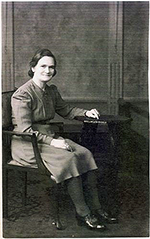
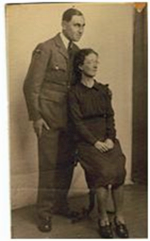
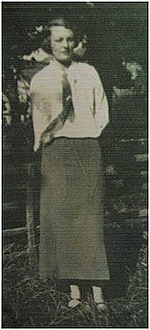
 World War 1 Pages
World War 1 Pages